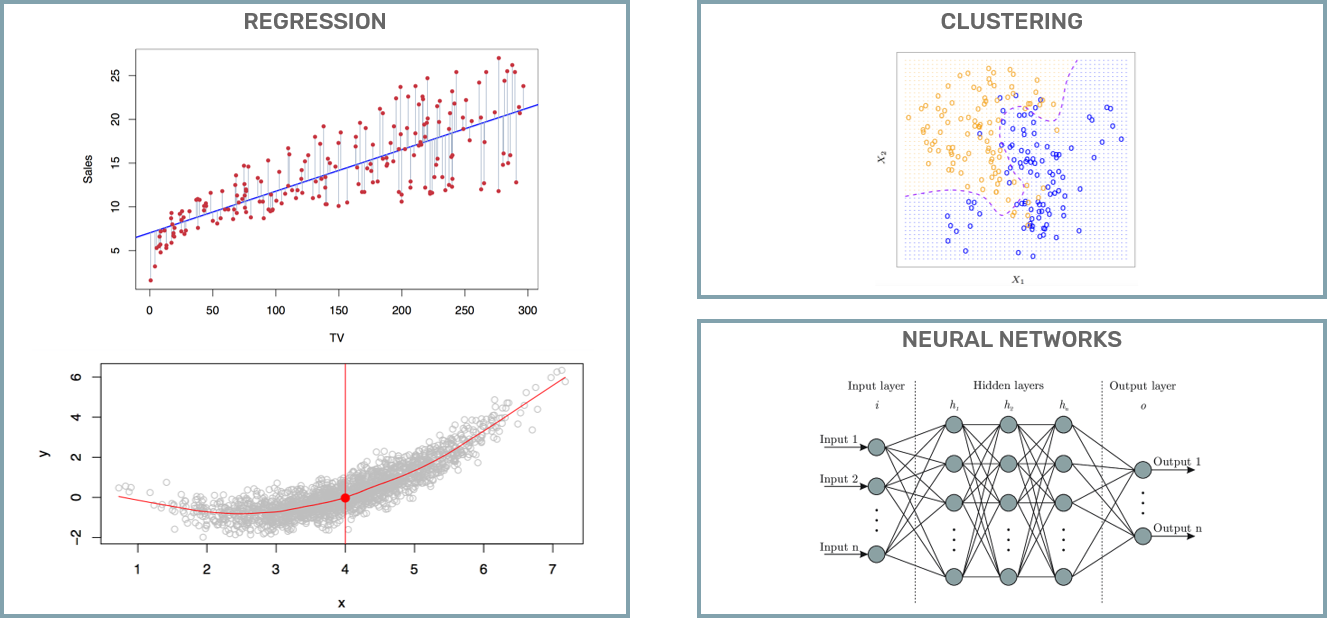Digital business excellence
Artificial Intelligence (AI) & Machine Learning (ML)
Definition of Artificial Intelligence and Machine Learning
Artificial intelligence (AI) refers to highly domain- or use case-specific problem solving through a computer algorithm. Machine learning (ML) comprises a class of generalized algorithms optimized for learning to solve specific input-output problems based on (typically: very large) training data sets. (Artificial) neural networks (ANN) are ML algorithms consisting of a net of «neurons» each accepting many weighted inputs and producing a single (continuous) output forwarded to the next neuron in the net. The determination of the individual weights of an ANN is called «training». Deep learning is ML based on ANNs with many (10-100+) pre-structured layers with 500k – 5M or more parameters.
Historically, initial generations of AI algorithms comprised
- Heuristic algorithms (e.g., older chess programs)
- Recommender systems
- Reinforcement learning
- Optimization algorithms
Today, ML has moved into the foreground (but also natural language processing, NLP) with basically two types of “learning” algorithms: supervised and unsupervised learning.
| SUPERVISED LEARNING | UNSUPERVISED LEARNING | ||
|---|---|---|---|
| DEFINITION | Correct outcome is known for a (large and detailed) set of training data. | No correct answer or outcome to the problem is known, just a list of raw data (called “features”). | |
| USE CASES |
|
|
|
| EXAMPLE ALGORITHMS |
|
|
Comparison of supervised v. unsupervised learning algorithms
The following diagram shows typical outputs of some AI algorithms and the internal structure of an ANN (bottom right).

Technology Evaluation
AI – especially in form of ML – is fueled by three drivers:
- Availability of massive training data (i.e., big data)
- Cheap access to the required enormous computing power (e.g., cloud).
- Improvements in AI/ML algorithms
Despite lighthouse successes (such as AlphaGo) applicability is still limited to fairly narrow problem domains and needs hefty AI/ML expertise. Individual AI solutions often do not generalize, models sometimes yield only trivial results, or they need to be trained separately for every single instance (e.g., each machine needing its own predictive maintenance model).
Automatic decision making is also increasingly met with considerable skepticism due to ethical considerations (e.g., unfair, discriminatory or unexplainable algorithms).
Market - Current Adoption
In 2019, a study estimated the worldwide AI market (with a generous and wide definition) to be anywhere between $ 10B-30B. This is roughly 10-15% of the global IaaS market. CAGR (compound annual growth rate) in the next few years will be around 30%.
Note that this statistic has to be interpreted very carefully as the vast majority of companies, ca. 70%, has not yet implemented a single (true) AI project, and only 9% have more than one AI solution running.
Market - Outlook
In the long run, AI has tremendous potential for all industries, significantly encouraged by “big data”, e.g., using all your machine or IoT data for AI. However, adoption will be much slower and more focused than hype or vendors (or some analysts) suggest because of the aforementioned adoption difficulties.
